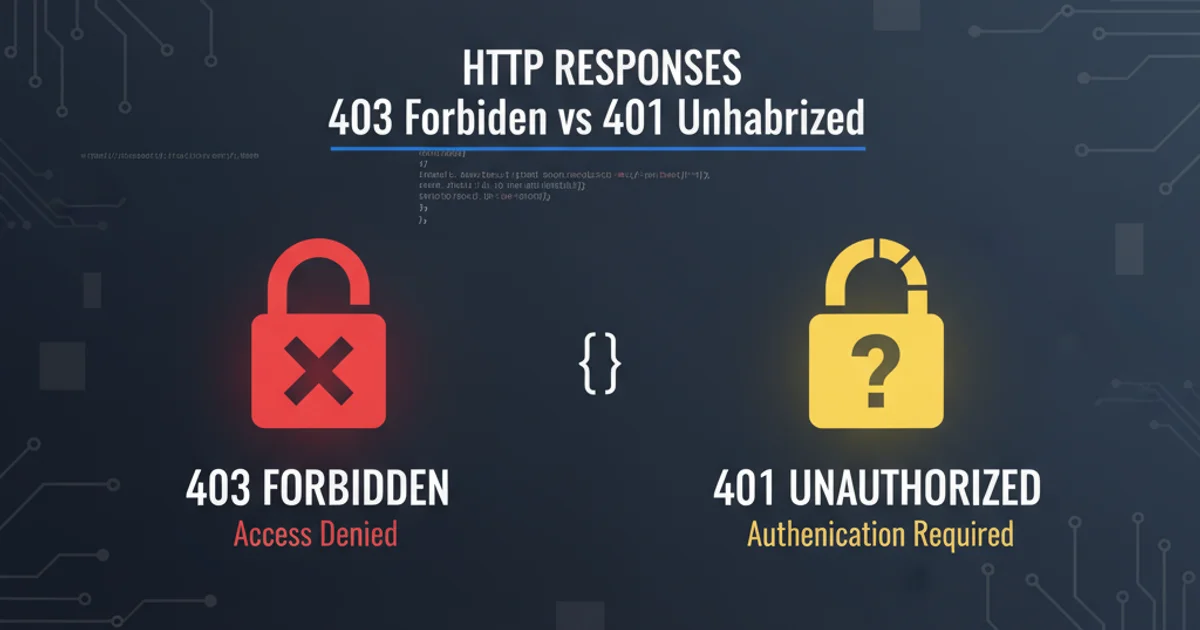403 Forbidden vs 401 Unauthorized HTTP responses
Categories:
403 Forbidden vs. 401 Unauthorized: Understanding HTTP Access Control

Demystify the critical differences between HTTP 403 Forbidden and 401 Unauthorized status codes, and learn how to implement them correctly for robust web security.
When building web applications, correctly handling access control is paramount for security and user experience. HTTP status codes 401 Unauthorized and 403 Forbidden are often confused, but they signify distinct issues related to a client's ability to access a resource. Understanding their nuances is crucial for both developers and system administrators to diagnose problems effectively and implement appropriate security measures.
401 Unauthorized: Authentication Required
The 401 Unauthorized status code indicates that the client request has not been authenticated. This means the server requires authentication credentials (like a username and password, or an API key) to grant access to the requested resource, but these credentials were either not provided or were invalid. It's essentially the server saying, "I don't know who you are, so I can't let you in."
When a server responds with 401 Unauthorized, it typically includes a WWW-Authenticate header. This header specifies the authentication scheme(s) supported by the server (e.g., Basic, Bearer, Digest) and provides instructions on how the client should authenticate. The client is expected to retry the request with valid credentials.
HTTP/1.1 401 Unauthorized
WWW-Authenticate: Basic realm="Access to the staging site"
Content-Type: text/html
Content-Length: 123
<!DOCTYPE html>
<html>
<head><title>401 Unauthorized</title></head>
<body><h1>401 Unauthorized</h1><p>Authentication required.</p></body>
</html>
Example HTTP 401 Unauthorized response with WWW-Authenticate header.
403 Forbidden: Authorization Denied
In contrast, the 403 Forbidden status code means the server understands the request and knows who the client is (i.e., the client has been authenticated), but it refuses to authorize access to the requested resource. This is often due to insufficient permissions. The server is saying, "I know who you are, but you don't have permission to access this specific resource."
Unlike 401 Unauthorized, a 403 Forbidden response does not typically include a WWW-Authenticate header, as authentication is not the issue. The client should not retry the request with the same credentials, as it will likely yield the same result. The user or client needs to obtain the necessary permissions or access a different resource.
HTTP/1.1 403 Forbidden
Content-Type: text/html
Content-Length: 115
<!DOCTYPE html>
<html>
<head><title>403 Forbidden</title></head>
<body><h1>403 Forbidden</h1><p>You do not have permission to access this resource.</p></body>
</html>
Example HTTP 403 Forbidden response.
flowchart TD
A[Client Request] --> B{Is Authentication Provided?}
B -- No --> C{Is Resource Public?}
C -- Yes --> D[200 OK]
C -- No --> E[401 Unauthorized]
B -- Yes --> F{Are Credentials Valid?}
F -- No --> E
F -- Yes --> G[Client Authenticated]
G --> H{Does Client Have Permission?}
H -- No --> I[403 Forbidden]
H -- Yes --> DDecision flow for HTTP 401 Unauthorized vs. 403 Forbidden.
Key Differences and When to Use Which
The distinction between 401 and 403 is fundamental to proper API design and web security. Here's a summary of their core differences:
- 401 Unauthorized: The client has not provided valid authentication credentials. The server doesn't know who the client is. The solution is for the client to authenticate.
- 403 Forbidden: The client has provided authentication (the server knows who they are), but they lack the necessary authorization to access the specific resource. The solution is to obtain permissions or access a different resource.
Using the correct status code helps clients (browsers, API consumers) understand the nature of the access problem and react appropriately. For instance, a browser might automatically prompt for credentials on a 401, but not on a 403.